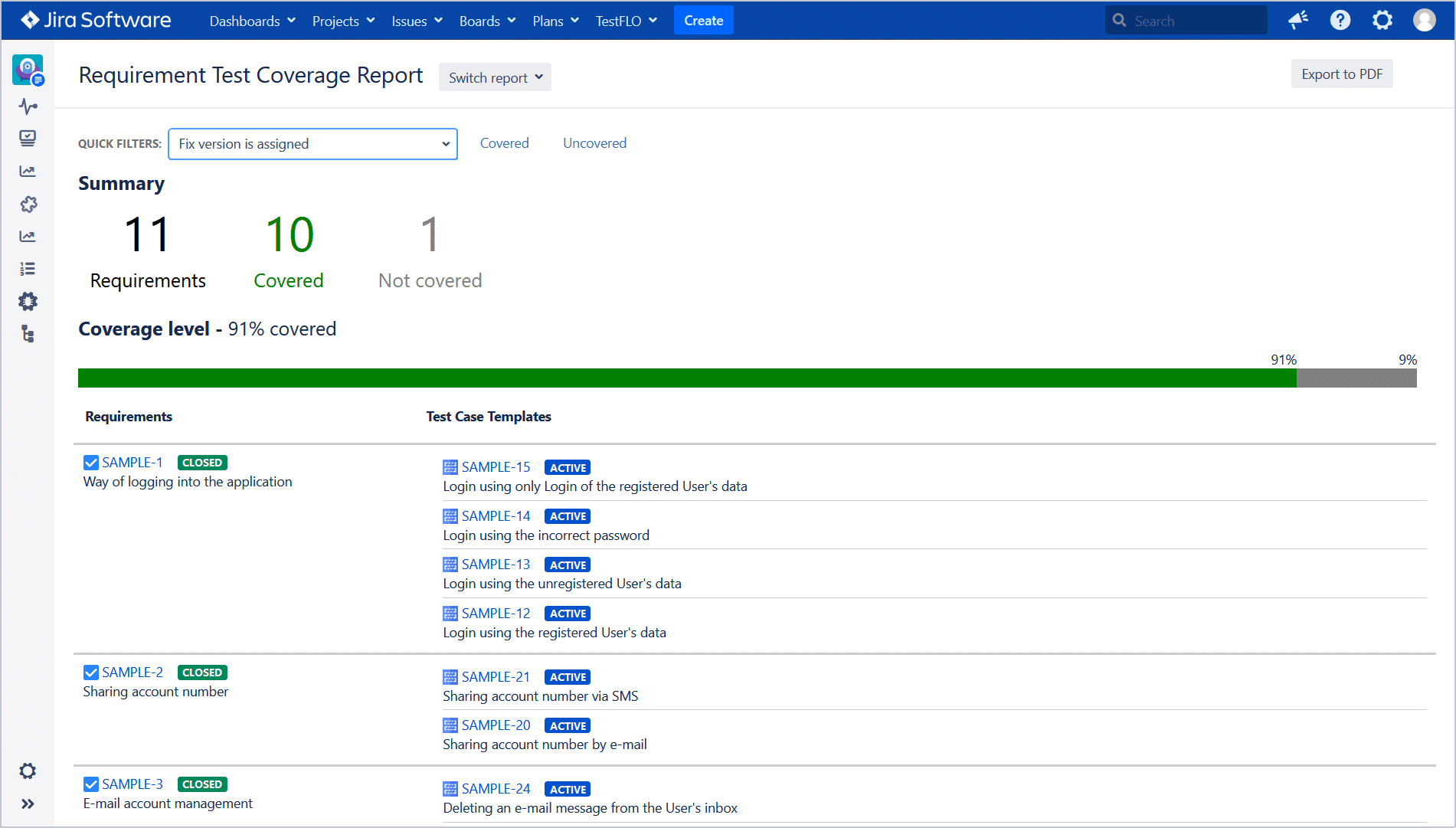How to report requirement test coverage in Jira

Updated by Tatiana Glazkova on April 29, 2021
Software development is a complex process that consists of multiple stages and requires the cooperation of numerous team members: testers, analysts, designers, developers, project managers, and others, depending on a project need. It’s crucial to always make sure that everyone’s keeping on track. To solve it, Deviniti has developed two useful applications – Requirements Test Management and TestFLO.
Benefits of testing in Jira
There are lots of reasons why managing tests in Jira are a smart way to go, but we need to properly estimate our needs first. Tracking relations between objects when our software development is scattered in different places is sometimes impossible to do. Very often requirements are stored in Confluence or Excel sheets, issues created in Jira, and tests executed in a dedicated tool.
Bringing your testing into Jira eliminates a majority of these problems. At this point, it’s worth remembering that when it comes to testing, Jira’s basic functionalities are usually not enough for more complicated projects. It may seem that testing in the Atlassian suite facilitates object tracking, but also has some disadvantages that separate tools don’t.
We’ve got a solution for that, too. A good idea is to mix the assets of both options and install a dedicated testing app for Jira that gives you seamless integration with a familiar environment. If you’re aiming for the best quality of the final product (and we’re sure you do!), this should be your choice. Not only you’ll be able to follow the progress every step of the way, but also link testing objects to Epics, user stories, and Jira issues.
The apps that let you benefit from all those functionalities are Requirements and Test Management for Jira (RTM) and TestFLO – Test Management for Jira. With their help, each member of the project has access to all the data including tasks, deadlines, performers, updates, and changes implemented throughout the process. Such a kind of workflow prevents misunderstandings, and duplicating tasks, and allows spotting and fixing possible mistakes right away.
Report your test results in RTM and TestFLO
One of the features of the apps – RTM and TestFLO – is a test report. The option distinguishes Deviniti’s apps from other testing tools as it allows to display all connections with the rest of the objects on a single screen. The apps allow for defining a complete testing process, including test case creation and linking to requirements. For now, different reports are possible to benefit from the apps. Each of your tests should be closely related to a requirement. Without that, you won’t be able to access your test’s coverage of a given requirement and verify which tests have already been designed.
Both RTM and TestFLO offer Traceability reports to track the relationship between requirements and analyze the overall testing effort for the requirements in a version.
Covering requirements is a process that allows controlling how many requirements have tests designed for them, what types of tests have been designed, and how much we still need to do before we are ready to pass our test paths to execution. If you’re working with numerous requirements, coverage reporting helps to save up a lot of time – we get the information we need quickly, instead of checking each requirement separately. A Requirement Test Coverage report in both applications allows tracking covered or uncovered requirements by tests for a given version to help you determine if all the requirements are closed with tests.
In RTM there is also a Test Case Executions (TCE) report generated to present all TCEs statuses and a Test Execution report to show the ratio of the run executions to all executions of the tests. The generated reports can be exported to a .csv or .pdf file, in a form ready to be presented if it is necessary.
To sum up, everyone who is involved in the project can easily generate any kind of report.
Requirement Coverage report
Checking the coverage of each requirement individually can be quite tricky – especially if you’re working with a version that contains dozens of them. When looking through requirements’ coverage, you probably want to have a quick view into particular requirements and their related tasks, as well as access to the most important information like the name or status of a given test and requirement. What is particularly important here are the requirements that have not been covered. Before starting the test execution phase, we need to be sure that the range of tests for a given version is complete.
How to set up the report?
The Requirement Test Coverage report in RTM shows whether the requirements are already covered or yet uncovered by related Test Cases, Test Plans, Test Executions, Test Case Executions, and Defects. We can choose which ones we’d like to display and track if there are any objects left that still need coverage. The next step is to select the filters among Project, Issue type, Fix version, Component, RTM Environment, and Assignee. If we don’t decide on any special fields, after clicking Generate we’ll get the relations of all existing requirements for a given project.
Each element on the table is described in detail, but if we don’t need all the information, we can hide some fields on Configuration Issue Card after clicking on the Preferences icon. The strong point of RTM Requirement Test Coverage is that we get all data in just one report, which can be customized with filters. This means, there’s no need to look for an adequate report for each stage of the software testing process, analyze its parts separately or waste time on putting several reports together. Now you have one tool to rule them all.
Requirement Test Coverage Report in TestFLO
Why track your software project with Coverage?
The number of usages of Requirement Coverage report is really high. Here are some reasons why is it a good idea to give RTM or TestFLO feature a try:
- thanks to the possibility of filtering covered and/or uncovered requirements, it’s easier to avoid omissions;
- transparent view of the elements instantly shows which requirements generate most bugs;
- if we define a Fix Version, the report simplifies finding defects from a specific version of a product;
- as we have all relations presented in one table, it lets us verify if the whole process from gathering requirements until test case execution is properly completed.
Discover more possibilities yourself and see how much information one report can give you in the form of a complete table, available and clear for everyone.
Key points
Tracking progress and relations between many elements is one of the greatest advantages of bringing your test management into Jira. Dedicated testing apps give you possibilities that separated tools or standalone Jira can’t provide. The RTM and TestFLO Requirement Coverage reports are much more universal than they may seem to be. They can be used not only for tracking requirements – test cases coverage results, but also distinguishing different types of requirements.
Deviniti is an Atlassian Platinum Solution Enterprise Partner and a Platinum Marketplace Partner. We’ve developed two Jira add-ons for requirements and test management, as well as dozens of applications for other purposes available on the Atlassian Marketplace. If you’re interested in gaining more knowledge about Jira Software as a test management solution, check out this video tutorial series on our YouTube.






